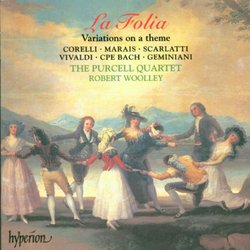| All Artists: Arcangelo Corelli, Marin Marais, Alessandro Scarlatti, Antonio Vivaldi, Carl Philipp Emanuel Bach, Francesco Geminiani, Purcell String Quartet, Purcell Quartet, Purcell Band, Robert Woolley Title: La Folia, Variations On A Theme Members Wishing: 1 Total Copies: 0 Label: Hyperion UK Release Date: 3/10/1998 Album Type: Import Genre: Classical Styles: Chamber Music, Forms & Genres, Concertos, Historical Periods, Baroque (c.1600-1750), Instruments, Strings Number of Discs: 1 SwapaCD Credits: 1 UPC: 034571170350 |
Search - Arcangelo Corelli, Marin Marais, Alessandro Scarlatti :: La Folia, Variations On A Theme
 | Arcangelo Corelli, Marin Marais, Alessandro Scarlatti La Folia, Variations On A Theme Genre: Classical
|
Larger Image |
CD Details |
CD ReviewsA unique but limited compilation Appassionata | Falls Church, Va. | 07/10/2005 (4 out of 5 stars) "I was drawn to this album for its unique compilation of "La folia" (pronounced "la foh-LEE-ah," literally meaning mad or empty-headed) -- arguably "the most lasting and famous tune in Western music" and "one of the most remarkable phenomena in the history of music," according to a breathtakingly comprehensive Web shrine, "La folia, a musical cathedral," which explores the hidden world of this famous 16th-century theme and endeavors to list all derivations and interpretations of it. The motif, with its characteristic harmonic pattern, has fascinated composers to the present day (many samples, including many by modern composers are available on that Web site). Truly, as a theme and variations, this CD may seem repetitive and boring to some. That would be a matter of personal taste. However, I am rather fascinated with it, even more so as I have learned of its history. Among the most famous and influential variations (and my favorites) are those of Arcangelo Corelli (Track No. 1) and Antonio Vivaldi (Track No. 4). I also enjoy the Geminiani. (...) For a bit of concise background, I excerpt and adapt a few paragraphs from "La folia, a musical cathedral." Its roots (linguistically, metaphorically, musically) of madness, dance, folly, fertility, and pleasure have captured the imagination of many. The taste offered by "La Folia, Variations on a Theme" is perhaps not yet the definitive collection, but for those entranced by La folia, it whets the appetite for more: "'Folía' (modern spelling; the old spelling lacked the accent, as was the norm in Spain during the sixteenth and seventeenth centuries) is of Iberian origin and refers to a fertility dance in three-four time originating in the late 15th century. In music Folia meant, at least till the 1670s, a very quick-paced and tumultuous dance, in which the dancers carried men dressed as women upon their shoulders. They were literally driven mad by the noise and the stirring rhythm. The 'early' Folia is sometimes called Folías españolas while the 'later' Folia might be indicated as Folías italianas. Derived from the Tuscan term 'Folle' (meaning empty-headed) the title Follia (with double LL) is used by many Italian composers. . . . The English word Folly has roughly the same meaning as the Tuscan term. In France the structure and its variations became known as Folies d'Espagne, with reference to its presumed origin. . . . "What is so special about this tune? "(1) The instant appeal of the music might be explained in the human's pursuit for balance. Speaking from a musicological point of view we are dealing with almost perfect symmetry and intricate harmonic layering. "(2) By far the most important reason is that it is very pleasant music to listen to. There is somehow an instant appeal for listeners and composers alike. It even sounds familiar when you have never heard the piece before. . . . Being captivated by the tune is of course a matter of personal taste, for there remain plenty of people who get bored by hearing only a couple of variations. "(3) From 1672 up to now the theme has not lost its power. . . . Composers are always looking for something that will give a piece instant flavour and character. La Folia variations provide lots of freedom too because there are no fixed numbers of variations to complete nor has there to be any structure between the variations. "(4) Finally there is the interesting social phenomenon that the music had its roots in popular culture and developed into a stately court dance; from a fertility dance for the people into a courtly flirtation." " Interesting album Mediamouse | Texas USA | 11/03/2009 (4 out of 5 stars) "This is interesting because it shows how six great composers used this basic theme, and put their individual stamp on it."
|

 Track Listings (6) - Disc #1
Track Listings (6) - Disc #1